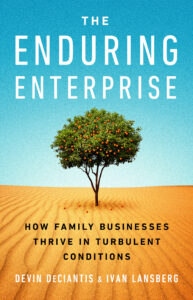The 50-50 sibling partnership suffers from a split personality but can generate synergies under certain conditions.
Imagine a business led by two siblings who share ownership and management responsibilities equally, yet are as unlike in style and personality as Beethoven and the Beach Boys. Imagine further that in this business no major decisions are made unless both partners agree, and no one has the power to break deadlocks when they occur.
Sound like a nightmare? It can be. Yet there are many successful sibling partnerships that are structured in just such a precarious way. In these companies, the partners develop a work relationship that is always complicated and, at times, even combative, but which sometimes manages to capitalize on their very differences to produce solid strategic decisions.
Obviously, such partnerships are not for everyone. But two-sib leadership may be the wave of the future in family businesses.
The number of sibling partnerships seems to be on the rise. A recent survey by Arthur Andersen of 3,000 family businesses in the United States found that 10 percent of the respondents had two people at the helm. My own research suggests that about two-thirds of all family businesses currently controlled by a single-owner manager are seriously considering creating a sibling partnership in the next generation. Since American families now have an average of only two children, the odds are that many companies will be run in the next generation by sibling pairs.
In successful two-person partnerships, the siblings often have complementary personalities and skills. The best of these partnerships epitomize the notion that the whole is greater than the sum of the parts. In his ground-breaking book on birth order, “Born to Rebel,” Frank Sulloway of MIT maintains that this differentiation among siblings evolves naturally in families as a result of intragroup competition for scarce resources—notably parental attention. Each child must develop a strategy to establish his or her unique identity and voice within the family. When there are only two children in a family, the pressures for differentiation may push the siblings to adopt personalities that are mirror images of each other: If one sibling is outgoing and gregarious, the other is likely to be reserved and bashful; if one is dominant and assertive, the other is more inclined to passivity and submissiveness.
Consider the case of two brothers who inherited a sizable chemical manufacturing company from their father. The brothers are four years apart in age. The oldest is calculating and mistrustful, the kind of person who always sees the glass as “half empty.” He abhors debt and prides himself on being a hard-nosed businessman. His office is decorated like an English manor, reflecting his conservative taste. In the partnership, this brother is the voice of financial restraint, prudence, and realism.
The younger brother, in contrast, is a driven, charismatic entrepreneur who believes “you’ve got to kiss a lot of frogs to find the prince.” His glass is always “half full.” His office is decorated with abstract art, high-tech equipment, and modern Italian furniture made of leather and chrome.
When the two brothers worked under their father, they formed an effective team that was able to counteract the patriarch’s often overbearing authority. After the father died, the brothers took charge of the company and have run it successfully as co-presidents for 32 years. The oldest brother has been mostly responsible for the manufacturing process. The younger brother is mainly in charge of marketing and sales, and has contributed many innovative ideas from which the business has derived much of its strategic dynamism.
Given their differences, it is hardly surprising that the brothers frequently argue—often passionately. The older brother generally voices skepticism about any contemplated change and argues in favor of incremental growth, while the younger one usually favors innovation, risk-taking, and fast growth. Although often frustrating, this pugilistic process, more often than not, improves the overall quality of strategic decisions.
As often happens in these partnerships, however, the system that served the brothers well over the years has run into trouble as they have grown older and had to cope with the stress of succession. Now in their 60s, the brothers have become less forgiving and tolerant of each other. Privately, each admits that he no longer has the energy required to argue with the other and reach consensus on major issues. Each brother wonders how things would have turned out if he alone had been allowed to run the business.
Worse, each brother has transferred his discontent with the current situation to his adult children in and out of the business. Each group of cousins, in turn, feels that, out of loyalty, they must align their views with their father’s, so the conflict has escalated into a rivalry between branches of the family. Under such circumstances, paralysis is virtually guaranteed in the business.
At the heart of the conflict between the brothers is the unconscious psychological dynamic known as “splitting.” Splitting occurs whenever people try to reduce the emotional discomfort they experience in a stressful situation by “splitting” off their own unwanted feelings and attributing them to another. One partner thus speaks for feelings that the other finds unacceptable in himself. By relying on the other to argue the opposite side of every issue, however, each sibling avoids responsibility for wrestling with the full complexity of issues they must decide. The devil’s advocate becomes the devil incarnate.
To overcome this condition, both siblings have to become aware of the win-lose mentality engendered by splitting, which oversimplifies their feelings toward each other and the issues to be decided. Occasionally, such awareness is forced on the siblings by external factors. For example, the oldest brother in the partnership I have described became incapacitated in a car accident and had to withdraw from day-to-day operations. The younger brother, who had to assume full charge of the company, later observed: “Isn’t it peculiar that since my brother left the business, I have become far more conservative and risk-averse? His voice has suddenly become part of my own thinking. I realize, in his absence, that all those years when I was arguing with him, I was actually arguing with myself.”
For a 50-50 sibling partnership to work in the long run, each partner must be able to see both sides of an argument when making important decisions rather than cling to a point of view shaped by a deep-seated psychological dynamic. Most successful two-sibling partnerships I have observed seem to derive their strength from the partners’ relentless commitment to the success of the business, to functional power-sharing, and consensus decision-making. The siblings realize that the 50-50 arrangement makes them dependent on each other and thus heightens their awareness of the need to cooperate.
For the arrangement to work, however, both siblings need to be committed to a common vision of the future—a shared dream—that focuses their efforts and pulls them in the same direction. The key seems to be in the siblings’ conviction that through pooling their talents, they can achieve greater success than if they went their separate ways. In other words, the benefits of interdependence and collaboration outweigh the sacrifice of personal control and glory.
Source: Family Business Magazine, Summer 1997
Copyright © 1997. Family Business magazine. Subject to the provisions of the Terms and Conditions of the Family Business Web Site, subscribers to Family Business magazine may print and distribute copies of this article, electronically or otherwise, provided that (a) such printing and distribution is done only for your personal, informational, non-commercial purposes, and (b) you do not remove or obscure the copyright notice or other notices. For other uses, including reprint permission for non-subscribers, contact Family Business magazine.








